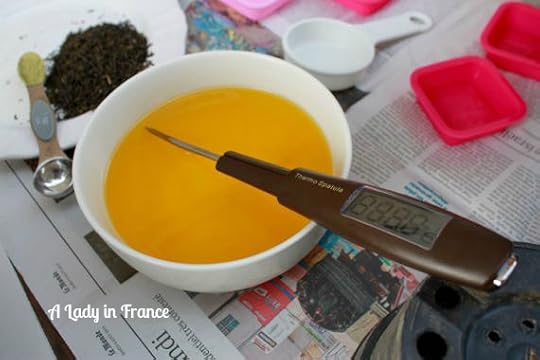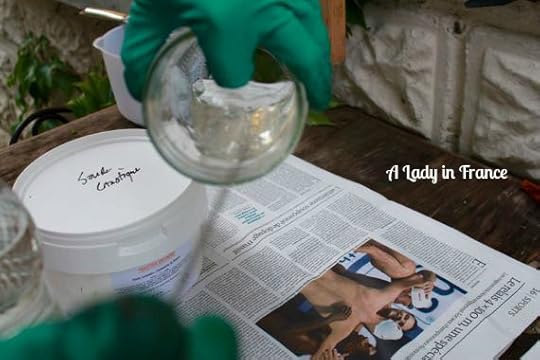How to Make Cold Process Soap (With Photos)
When I set out to make cold process soap, I was looking for a step-by-step process with photos. I wanted to know what it looked like when you poured the lye into the water. To tell you the truth, I was afraid I would blow something up. Since I was entirely successful (and am confident you will be too), I decided to photograph the soap-making process for you. It takes the mystery away.
So this is my week of soap. You’ll either love it or you’ll hate it, depending on how interested you are in making your own soap. (But I do promise to include pretty pictures each time, and will be back to my regularly-scheduled programming next week).
I got the recipe and instructions from DIY Natural, and have not strayed from the exact proportion of oils, temperatures and lye quantity. These have not failed me yet, so many thanks to Betsy for providing such a reliable recipe – and for the safety tips.
I also took tips from Kenna from Modern Soapmaking. She tells which ingredients to use to get what you desire out of the soap, whether it be lots of lather or something durable and long-lasting. I recommend clicking on both of their links and checking their sites out for some expert guidance.

I don’t know what prompted me to want to make soap, but I’m sure it had to do – at least, in part – with all the lavender in our garden. I have this desire to use what we have, even if crafting and homemaking is not my strong suit.
But for this first recipe, I made green tea soap. I used matcha powder and green tea leaves, but that creates a dark soap. If you want to go lighter, you can skip the matcha. I just wondered if the benefits of green tea extended to an exterior usage, as well as an interior. In either case, the green tea leaves are a natural loofah.
Here’s what you need to do. Prepare 3 different oils – 2/3 cup of each. You’ll need coconut oil and olive oil for sure. One makes the lather, and the other makes the hardness that keeps the soap from falling into pieces. And then you need a third oil – grapeseed or canola or almond or the like.
Measure out 1/4 cup of green tea leaves and 1 teaspoon of matcha (if you decide to use it and have the darker coloured soap).

Measure out 3/4 c distilled water into a mason jar. Put 1/4 cup lye crystals to the side so that it’s handy. You should be wearing gloves and long sleeves, pants, and closed toed shoes when you measure the lye, but it’s even more important when you mix it with the water. So have all those things handy.

You’ll need two thermometers – one long for the mason jar, and one shorter (like a candy thermometer).
And then make sure you have your immersion blender. This is indispensable – it won’t (easily) work any other way. Not by electric mixer, not by hand mixing.
And you need soap molds. The ones I bought online were smaller than I expected, so I supplemented with a 6-cup silicone cupcake pan. I was easily able to pop the soap out when it was done.
When you’re ready to start, heat the three oils together in the microwave for one minute.

Then, you want to start pouring the lye crystals very slowly into the water. The lye heats up the water through a chemical process. Do NOT dump them in all at once because it could cause an explosion if they lump together. Pour them in slowly.
(I rarely scream on my blog, but this part was worth a little yelling to make sure you don’t hurt yourself).

I know, I know. It seems scary, right? I asked my husband to help me with this part while I took pictures.

He kept stirring with a spatula until all the crystals were dissolved and the water was clear again, being careful not to breathe in the fumes. The fumes were not as scary as I thought (I read that they can sometimes make you feel a tightness in your throat). But do make soap in a heavily ventilated area, like the outdoors.

And then we just needed to wait. You need for the both the oil mixture and the lye mixture to return to a lower temperature – between precisely 95° and 105° F. Every time I’ve made soap, I still needed to heat the oils again for another 20 seconds since they cooled off faster than the lye.
And here’s the surprising part – from the time the oils and lye mixture cool down enough to be in the proper range … it takes about one hour. I had no idea it would be that long and I thought you would like to know.
When it’s ready, pour the lye mixture very slowly into the oil mixture and stir by hand for 5 minutes.
 You want to make sure that every oil particle touches every lye particle (if that’s possible) so that the saponification can begin.
You want to make sure that every oil particle touches every lye particle (if that’s possible) so that the saponification can begin.
I want to mention here that once the lye mixes with the oil and saponifies, it is no longer harmful to your skin. Do make sure the soaps sit and cure for a month before you use them.


 After timing the hand-mixing out for 5 minutes, add your tea and use an immersion blender to thoroughly blend it together.
After timing the hand-mixing out for 5 minutes, add your tea and use an immersion blender to thoroughly blend it together.
(You’ll notice that I forgot, and added my tea while I was hand mixing, but it made no difference – the soap still turned out perfectly).

It should take another 5 minutes or so, but you’re looking for the texture to change and become more like vanilla pudding. That’s when it’s at “trace.” It changes color a bit too. Some of my soaps take longer than other to reach trace.

Put the soap in the molds. Now, while it won’t hurt your skin as much as pure lye, I found that it’s irritating before it’s has a chance to cure. So keep your gloves on.

When you have them all in the molds, cover them with saran wrap

and wrap them with a towel or two. This keeps the heat in and allows the saponification to continue. You’re going to keep it like that for 24 hours before popping the soaps out of the mold. I put them on a tiered filing tray with metal trays that allowed the soaps to breathe, and then I covered them loosely with a towel. That way I didn’t have to turn them over once a week to make sure the air reached all sides.

What to do with the equipment? Well, first of all I recommend setting aside the material for soap-making use exclusively. We have an immersion blender, a bowl, a 1/4 measure cup, a spatula, and a mason jar only for soap-making.
To clean the mason jar, we put white vinegar and swirled it around on all sides with the thermometer to neutralize the lye.

For the rest, I waited a couple of days before washing everything so that the mixture had saponified even further. And then I just used hot water. The soap is already in there! 



